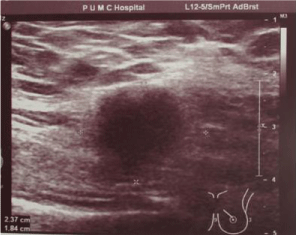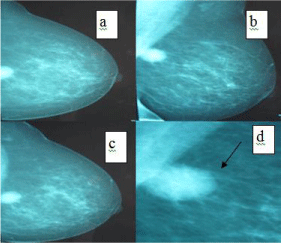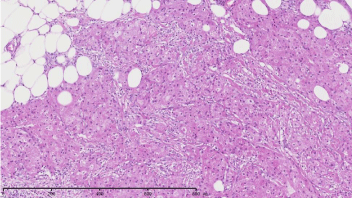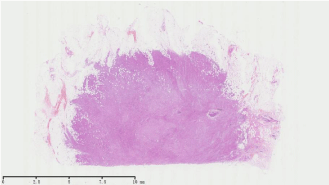Case Report
Granular Cell Tumor of the Breast in a Chinese Woman Mimicking Breast Cancer-Case Report and Literature Review
Xiaohui Zhang, Joseph P. Crowe, Feng Cai and Qiang Sun*
Department of Breast Surgery, Peking Union Medical College Hospital and Chinese Academy of Medical Science, China
*Corresponding author: Qiang Sun, Department of Breast Surgery, Peking Union Medical College Hospital and Chinese Academy of Medical Science, Beijing, China
Published: 01 Dec, 2016
Cite this article as: Zhang X, Crowe JP, Cai F, Sun Q.
Granular Cell Tumor of the Breast in
a Chinese Woman Mimicking Breast
Cancer-Case Report and Literature
Review. Clin Surg. 2016; 1: 1187.
Abstract
1. Granular cell tumor of the breast is rare but benign in most conditions.
2. GCTB is very easy to be misdiagnosed as primary breast cancer clinically.
3. GCTB is reported to be more common in pre-menopasual African American female but few in Asia.
4. Here we present the first Chinese woman with GCTB mimicking breast cancer.
5. In the condition that this woman was strongly against needle biopsy and was scheduled to receive mastectomy by another hospital, wide local excision was managed reasonably and successfully.
Introduction
Granular cell tumor (GCT) was described first in the tongue (1926) and later in the breast by
Abrikosoff (1931) [1-2]. It was ever thought to originate from skeletal muscle at first and then from
peripheral nerves. Now it has been recognized to occur in various sites including the oral cavity,
head, neck, chest wall, and digestive tract [3].
GCT of the breast (GCTB) is rare, accounting for 5- 6% of all GCTs. It is usually benign with
an exception of only 5 malignant cases reported globally [4,5]. As a solid tumor of the breast, the
incidence of GCTB is extremely low compared with breast carcinoma with a rate of about 1 to 1000
[6]. GCTB is reported to be more common in pre-menopasual African American females than white
and Asian females [4,7]. To date there are no reported cases of GCTB from China.
Although GCTB is usually benign, it can be misdiagnosed as a primary breast cancer because
of its mimicking features and rare incidence. GCTB can manifest to be firm and non-movable mass
with distinct borders and spiculations both mammographically and sonographically, which can
mimick that of breast cancer in most situations. Therefore fine needle aspiration and core needle
biopsy should be very helpful to the diagnosis of GCTB.
- Department of Breast Surgery, Peking Union Medical College Hospital, Beijing, China
- Department of General Surgery, Cleveland Clinic, Cleveland, United States
- Department of Radiology, Peking Union Medical College Hospital, Beijing, China
Here, we present a postmenopausal Chinese woman with GCTB. And also the challenge of treatment is that this woman was strongly against needle biopsy.
Case Presentation
A 53-year-old postmenopausal woman presented with a 2-week history of a painless mass
in the upper inner quadrant of her left breast. She had no family history of any cancer. Clinical
breast exam revealed a 3 cm, firm, non-movable mass. Axillary lymph nodes were not enlarged.
Upon presentation at another hospital, she got a clinical diagnosis of breast cancer and had been
scheduled to receive mammary radical mastectomy. She refused needle core biopsy because she was
extremely concerned about spreading cancer cells along the needle biopsy track. Ultrasound showed
a 2.4 x 2.0 x 1.8 cm hypoechoic, hypovascular mass with indistinct borders at 10’clock. It was close
to the underlying pectoralis major muscle but was not obviously invading the muscle (Figure 1).
Mammography revealed a round mass close to the pectoralis major
muscle with subtle spiculations at the margin (Figure 2).
The round mass shows partly in CC view but entirely in XCCM
view. It is close to the pectoralis major muscle in the MLO view and
the arrows in the last enlargement view show subtle spiculations at
the margin.
The patient underwent a wide local excision of the left breast mass. Pathological examination of the frozen section did not reveal a typical infiltrating breast cancer but suggested “ suspicious GCTB”. Then incision was closed and the patient got her breast saved happily for she had been diagnosed breast cancer and scheduled to receive mammary radical mastectomy by the former hospital. Final pathology confirmed the diagnosis of GCTB. It revealed typical granular cells with abundant pink granular cytoplasm and small, hyper chromatic nuclei (Figure 3). The margin was tumor free (Figure 4). The immunohistochemistry showed the tumor was positive for S-100 and negative for AE1/AE3, CgA and SMA. The immunostains were positive for S-100 protein.
Figure 1
Figure 2
Figure 2
Mammography in different views.
a. Cranio-caudal view
b. Medio-lateral oblique view
c. Cranio-caudal
exaggerated medially view
d. Medio-lateral oblique view enlargement
Figure 3
Figure 3
Pathologic specimen revealed polygonal cells containing abundant granular eosinophilic cytoplasm and small, hyperchromatic, centric or eccentric nuclei consistent with a granular cell neoplasm.
Figure 4
Discussion
GCTB is a rare disease without enough data until now. The largest
reports come from United States in which it is reported to be more
common in African American female at a ratio ranges from 70% to
94% [4,7-17]. There are also some sporadic cases from asia but no
report in Chinese woman throughout pubmed [4,7].
Based on current theory that GCT is thought to be likely from
Schwann cells of peripheral nerves. GCT can happen every site where
peripheral nerves exist. GCTB arises from intralobular breast stroma
within which the cutaneous sensory branches of the supraclavicular
nerve distribute. While the cutaneous branches of supraclavicular
nerve spreads in a fan-like direction in the upper inner quarter of the
breast, that give us a good explanation why GCTB is most commonly
seen in the upper inner quarter of the breast [11].
Clinically, GCTBs present typically as firm, palpable masses
between 1cm to 3cm in size. They occur more frequently in the
upper inner quarter [4,7] in contrast to breast carcinoma, which is
more usually located in the upper outer quadrant. GCTBs can cause
dimpling of skin, infiltration, or ulceration, all features that mimick
the appearance of breast cancer and can lead to an incorrect clinical
diagnosis [12].
Mammagraphically, they can appear as an isodense mass with
indistinct or spiculated margins. Sonographically, they sometimes
show the characters such as heterogeneous echotexture, indistinct
margins and hypervascularity [7,11,13]. Many infiltrating breast
cancers have similar imaging findings.
Grossly, GCTB is usually firm, grayish white to yellow mass.
Fine needle aspiration cytology sometimes is useful and experienced
cytopathologists look for cells with ill-defined abundant granular
cytoplasm and bland, regular small and round nuclei which support
the diagnosis of GCTB [14,15]. Core needle biopsy is very helpful
and 70% patients were diagnosed by core needle biopsy in Irshad’s
report [7]. GCTB characteristically shows typical granular cells with
abundant pink granular cytoplasm and small, hyperchromatic nuclei
in routine pathology [12]. High mitotic rate, cellular and nuclear
pleomorphism, and the presence of necrosis suggest malignant
GCTB (MGCTB) [16]. In most of these tumors, the immunostains
are positive for S-100 protein, which favors the theory of its neural
origin.
Wide local excision with free margin is the appropriate treatment
for GCTB [4,12], especially in the condition which pre-operation
pathology is uncertain or invalid. The recurrent rate after wide local
excision is low. In Papalas’ report, all patients which included 15%
patients with positive margins and 31% with close margins (tumor
cells within 1mm) remained disease free during a 77-month followup
[17]. However, there are only 5 cases of MGCTB reported in the
English-language literature [16]. In the recent report from Japan, a
female in her 80’s who underwent local and axillary recurrence 15
months after local excision received MRM and then died of liver and
lung metastasis 34 months after primary surgery. The author suggest
that wide local excision with axillary lymph node dissection, clear
margin and close follow-up are necessary if the pathology reveals
MGCTB [16].
Conclusion
We report the first case of GCTB in Chinese woman mimicking breast carcinoma clinically and radiologically. Wide local excision with free margin is reasonable when pre-operation pathology is not valid. It is very important that surgeons and pathologists are aware of this entity and do not mistake it for breast cancer and proceed to mastectomy without definitive histology.
References
- Abrikossoff A. Über Myome, ausgehend von der quergestreiften willkürlichen Muskulatur.Virchows Arch Pathol Anat Physiol. 1926; 260: 215–233.
- Abrikosoff A. Weitere untersuchungen uber mublastenmyome. Virchow Arch Path Anat. 1931; 280: 723.
- Lack EE, Worsham GF, Callihan MD, Crawford BE, Klappenbach S, Rowden G, et al. Granular cell tumor: a clinicopathologic study of 110 patients. J Surg Oncol. 1980; 13: 301-316.
- Adeniran A, Al-Ahmadie H, Mahoney MC, Robinson-Smith TM. Granular cell tumor of the breast: a series of 17 cases and review of the literature. Breast J. 2004; 10: 528-531.
- Qureshi NA, Tahir M, Carmichael AR. Granular cell tumour of the soft tissues: a case report and literature review. Int Semin Surg Oncol. 2006; 3: 21.
- Khansur T, Balducci L, Tavassoli M. Granular cell tumor. Clinical spectrum of the benign and malignant entity. Cancer. 1987; 60: 220-222.
- Irshad A, Pope TL, Ackerman SJ, Panzegrau B. Characterization of sonographic and mammographic features of granular cell tumors of the breast and estimation of their incidence. J Ultrasound Med. 2008; 27: 467- 475.
- DeMay RM, Kay S. Granular cell tumor of the breast. Pathol Annu. 1984; 19: 121-148.
- Mazur MT, Shultz JJ, Myers JL. Granular cell tumor: immunohistochemical analysis of 21 benign tumors and one malignant tumor. Arch Pathol Lab Med. 1990; 114: 692-696.
- Yang WT, Edeiken-Monroe B, Sneige N, Fornage BD. Sonographic and mammographic appearances of granular cell tumors of the breast with pathological correlation. J Clin Ultrasound. 2006; 34: 153-160.
- De Simone N, Aggon A, Christy C. Granular cell tumor of the breast: clinical and pathologic characteristics of a rare case in a 14-year-old girl. J Clin Oncol. 2011; 29: 656-657.
- Anna C Brown, Riccardo A Audisio, Peter Regitnig. Granular cell tumour of the breast, Surgical Oncology. 2011; 20: 97-105.
- Porter GJ, Evans AJ, Lee AH, Hamilton LJ, James JJ. Unusual benign breast lesions. Clin Radiol. 2006; 61: 562-569.
- Rossi ED, Mule' A, Miraglia A, Cianfrini F, Zannoni GF, Fadda G. Granular cell tumour on conventional cytology and thin-layer smears. Cytopathology. 2005; 16: 259-261.
- El Aouni N, Laurent I, Terrier P, Mansouri D, Suciu V, Delaloge S, et al. Granular cell tumor of the breast. Diagn Cytopathol. 2007; 35: 725-727.
- Akahane K, Kato K, Ogiso S, Sakaguchi K, Hashimoto M, Ishikawa A, et al. Malignant granular cell tumor of the breast: case report and literature review. Breast Cancer. 2015; 22: 317-323.
- Papalas JA, Wylie JD, Dash RC. Recurrence risk and margin status in granular cell tumors of the breast: a clinicopathologic study of 13 patients. Arch Pathol Lab Med. 2011; 135: 890-895.




